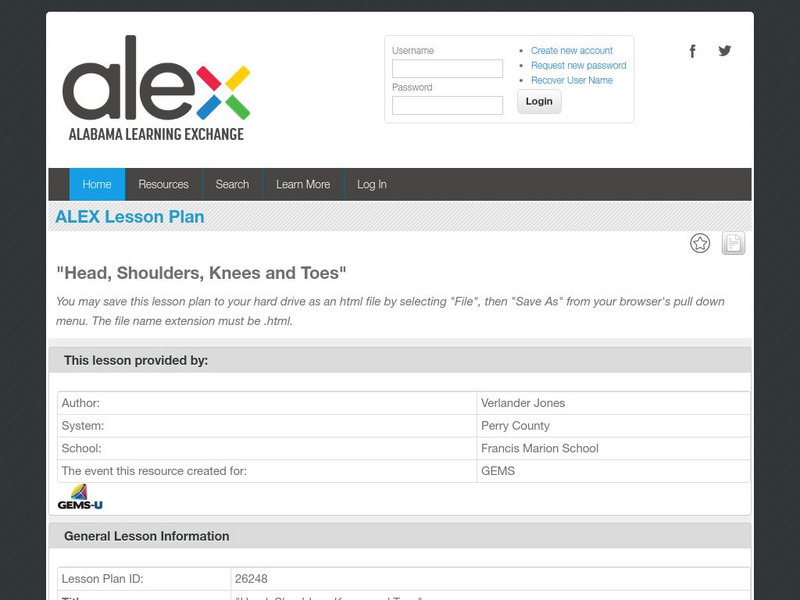Curated OER
Animals and Humans
Students identify the functions of various body parts. They participate in the "Head, Shoulders, Knees, and Toes" song, draw a picture of themselves and other mammals, and create a traced outline of their body that they add features to....
Alabama Learning Exchange
Heads, Shoulders, Knees, and Toes
The identification of various parts of the human body is the focus of this biology lesson. Young scientists sing the song "Head, Shoulders, Knees, and Toes," and trace the human body onto butcher paper. Additionally, they label the parts...
Alabama Learning Exchange
Systems of the Human Body
Young scholars research systems of the human body. In this biology activity, students read the book Yucky Story and identify the systems of the human body. Young scholars create a Powerpoint presentation to demonstrate their knowledge of...
Curated OER
SHARK BODY PARTS
Students list all the parts on the shark and label a diagram of the shark anatomy. They define the words, "gill and fin" and describe what they are used for.
Curated OER
ESOL Lesson, Beginning
Students identify the names of body parts on flashcards. The students participate in a "L" game, and illustrate a puppet and name the body parts. Students also identify the names for popular fruit. Students use all senses to distinguish...
Curated OER
Measuring Ourselves
Fifth graders conduct various measurement activities on themselves and a partner. They measure their height, weight, thumb-to-pinky span, and body temperature, recording the information in the form of an Excel spreadsheet.
Curated OER
I Can See You
Second graders explore living without sight. In this senses lesson, 2nd graders review the different senses and what they use for each sense. Students discuss what it would be like to not be able to see and they read a story about a...
Curated OER
Those Cells Look Good Enough to Eat
Pupils explore the parts of the cell. In this cell lesson plan, students use foods to create cell models that represent the nucleus, cytoplasm, cell membrane, mitochondria, ribosomes, vacuoles, endoplasmic reticulum, and Golgi bodies...
Curated OER
What Does a Monarch Caterpillar Eat?
Second graders study what monarch caterpillars eat by solving math problems and reading The Girl Who Loved Caterpillars: A Twelfth-Century Tale from Japan. They analyze why Monarch caterpillars only eat milkweed leaves and solve...
Curated OER
Meat, Poultry, Fish, Eggs: Constructing and Maintaining
Meat as a food source to provide necessary complete protein, iron, and other nutrients in the diet. Identify and prepare meats and/or poultry product(s). National Standard 14.3.3
Curated OER
The Witch of Goingsnake
Students complete literary analysis activities using proverbs. In this proverbs lesson, students interpret a proverb and discuss the structure of poems. Students write essays explaining the summary statement and complete a Venn diagram...
Curated OER
Value: Love Consideration
Students explore the importance of being considerate to others. Students read a story about consideration and sing a song. In groups, students pretend to have a broken leg, toothache, etc. Group members determine ways to assist the...
Alabama Learning Exchange
Alex: "Head, Shoulders, Knees and Toes"
Students will have the opportunity to learn names of many parts of the human body and how they help the body function healthy. Students will put a skeleton together to create a full human body.This lesson plan was created as a result of...











